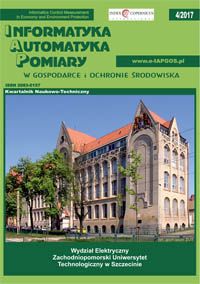MAXIMUM SUBARRAY PROBLEM OPTIMIZATION FOR SPECIFIC DATA
Article Sidebar
Open full text
Issue Vol. 7 No. 4 (2017)
-
SELECTED PROBLEMS OF EVALUATION AND CLASSIFICATION OF HISTORICAL BUILDINGS USING ROUGH SETS
Krzysztof Czajkowski5-10
-
LABORATORY STAND FOR SMALL WIND TURBINE SIMULATION
Wojciech Matelski, Eugeniusz Łowiec, Stanisław Abramik11-14
-
DEVELOPMENT OF AN AUTOMATED DIAGNOSTICS AND CONTROL SYSTEM FOR BIOGAS COMBUSTION PROCESSES
Oxana Zhirnova15-19
-
SUPPLY CHAIN RISK MANAGEMENT BY MONTE CARLO METHOD
Tomasz Rymarczyk, Grzegorz Kłosowski20-23
-
THE USE OF PETRI NETS IN DECISION SUPPORT SYSTEMS BASED ON INTELLIGENT MULTIPLY SOURCE DATA ANALYSIS
Tomasz Rymarczyk, Grzegorz Kłosowski, Tomasz Cieplak24-27
-
APPLICABILITY ANALYSIS OF REST AND SOAP WEB SERVICES
Tomasz Zientarski, Marek Miłosz, Marek Kamiński, Maciej Kołodziej28-31
-
A REVIEW OF CONTROL METHODS OF WIND TURBINE SYSTEMS WITH PERMANENT MAGNET SYNCHRONOUS GENERATOR
Piotr Gajewski32-37
-
DIRECT TORQUE CONTROL OF MULTI-PHASE INDUCTION MOTOR WITH FUZZY LOGIC SPEED CONTROLLER
Jacek Listwan38-43
-
IMAGE COMPLETION WITH LOW-RANK MODEL APPROXIMATION METHODS
Tomasz Sadowski, Rafał Zdunek44-48
-
APPROXIMATION OF ELECTRIC PROPERTIES OF PERIODIC LAYERED COMPOSITE MATERIALS
Adam Steckiewicz, Bogusław Butryło49-52
-
BOOST QUASI-RESONANT CONVERTERS FOR PHOTOVOLTAIC SYSTEM
Michał Harasimczuk53-56
-
RESEARCH OF FLOW AROUND SELECTED SENSORS PROFILES FOR METROLOGY FLOWS
Piotr Zgolak57-61
-
MAXIMUM SUBARRAY PROBLEM OPTIMIZATION FOR SPECIFIC DATA
Tomasz Rojek62-65
-
ANALYSIS OF POWER LOSS IN THE LOW-SPEED PNEUMATIC ENGINE
Adam Ilnicki, Mariusz Rząsa66-69
-
APPLICATION OF FUZZY COGNITIVE MAP TO PREDICT OF EFFECTIVENESS OF BIKE SHARING SYSTEMS
Aleksander Jastriebow, Łukasz Kubuś, Katarzyna Poczęta70-73
-
FUZZY COGNITIVE MAP AS AN INTELLIGENT RECOMMENDER SYSTEM OF WEBSITE RESOURCES
Aleksander Jastriebow, Łukasz Kubuś, Katarzyna Poczęta74-78
-
MODELING OF THE ARTIFICIAL BLOOD CHAMBER AND THE MICROPUMPS PULSATILE DRIVE FOR BLOOD TRANSFUSION
Sebastian Bartel79-81
-
CONTROL A SMALL WIND TURBINE WITH ASYNCHRONOUS GENERATOR
Kamil Możdżyński, Tomasz Gajowik, Krzysztof Rafał, Mariusz Malinowski82-87
-
MECHANICAL PROPERTIES OF SELECTED EPOXY ADHESIVES
Izabela Miturska, Anna Rudawska88-91
-
POLYNOMIAL APPROXIMATION FOR T WAVE PARAMETER RECOGNITION IN ECG PROCESSING
Marcin Maciejewski92-95
-
THE IMPACT OF WINDOW FUNCTION ON IDENTIFICATION OF SPEAKER EMOTIONAL STATE
Paweł Powroźnik, Dariusz Czerwiński96-100
-
USE OF MULTICRITERIAL OPTIMIZATION IN FURNITURE MANUFACTURING PROCESS
Grzegorz Kłosowski, Edward Kozłowski101-106
-
MODEL OF DYNAMIC ELEVATOR CONTROL SYSTEM USING CENTRAL APPLICATION SERVER
Łukasz Furgała, Krzysztof Kolano, Włodzimierz Mosorow107-112
Archives
-
Vol. 9 No. 4
2019-12-16 20
-
Vol. 9 No. 3
2019-09-26 20
-
Vol. 9 No. 2
2019-06-21 16
-
Vol. 9 No. 1
2019-03-03 13
-
Vol. 8 No. 4
2018-12-16 16
-
Vol. 8 No. 3
2018-09-25 16
-
Vol. 8 No. 2
2018-05-30 18
-
Vol. 8 No. 1
2018-02-28 18
-
Vol. 7 No. 4
2017-12-21 23
-
Vol. 7 No. 3
2017-09-30 24
-
Vol. 7 No. 2
2017-06-30 27
-
Vol. 7 No. 1
2017-03-03 33
-
Vol. 6 No. 4
2016-12-22 16
-
Vol. 6 No. 3
2016-08-08 18
-
Vol. 6 No. 2
2016-05-10 16
-
Vol. 6 No. 1
2016-02-04 16
-
Vol. 5 No. 4
2015-10-28 19
-
Vol. 5 No. 3
2015-09-02 17
-
Vol. 5 No. 2
2015-06-30 15
-
Vol. 5 No. 1
2015-03-31 18
Main Article Content
DOI
Authors
Abstract
The maximum subarray problem (MSP) is to the find maximum contiguous sum in an array. This paper describes a method of Kadanes algorithm (the state of the art) optimization for specific data (continuous sequences of zeros or negative real numbers). When the data are unfavourable, the modification of the algorithm causes a non significant performance loss (1% > decrease in performance). The modification does not improve time complexity but reduces the number of elementary operations. Various experimental data sets have been used to evaluate possible time efficiency improvement. For the most favourable data sets an increase in efficiency of 25% can be achieved.
Keywords:
References
Lloyd A.: Longest biased interval and longest non-negative sum interval. Bioinformatics 19, 2003, 1294–1295.
Bae Sung Eun: Sequential and Parallel Algorithms for the Generalized Maximum Subarray Problem. Ph.D. Thesis, University of Canterbury, 2007.
Bentley J.: Programming pearls: algorithm design techniques. Communications of the ACM, 27(9), 1984, 865–873.
BT Series Broadcasting. Parameter values for the HDTV standards for production and international programme exchange BT Series Broadcasting service – volume 5, 2002.
Grenander U.: Pattern analysis. Springer, 1978.
Huang X.: An algorithm for identifying regions of a DNA sequence that satisfy a content requirement. Computer applications in the biosciences: CABIOS 10, 1994, 219–225.
Larson R. C., Odoni A. R.: Urban operations research. Prentice-Hall, New Jersey 1981.
Lin Yaw Ling, Jiang Tao, Chao Kun Mao: Efficient algorithms for locating the length-constrained heaviest segments with applications to biomolecular sequence analysis. Journal of Computer and System Sciences 65, 2003, 570–586.
Perumalla K., Deo N.: Parallel algorithms for maximum subsequence and maximum subarray. Parallel Processing Letters 5(03), 1995, 367–373.
Tokyo IBM: Data Association Mining Rules: Using Algorithms, Optimized and Scheme, Visualization, 1996.
Wang L., Xu Ying: SEGID: Identifying interesting segments in (multiple) sequence alignments. Bioinformatics 19, 297–298, 2003.
Article Details
Abstract views: 290
License

This work is licensed under a Creative Commons Attribution-ShareAlike 4.0 International License.






